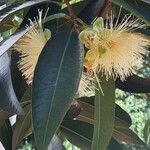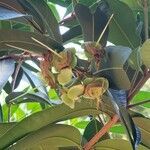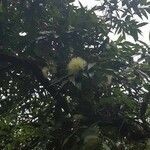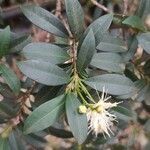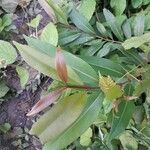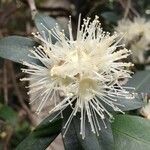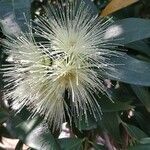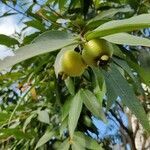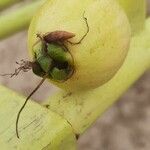An evergreen tree. It grows up to 7.5-15 m tall and with a spread of 4 m. It can be a small shrub. The stem is erect and 20-40 cm across. The branches hang downwards. The bark is greyish-green. The young twigs are either flattened of somewhat square in cross section. The leaves are simple, thick and shiny. The leaves are narrow and pointed (10-20 cm long and 3-4 cm wide). They taper towards both ends. Young leaves are brownish red coloured. The leaves have 16-18 pairs of side veins which join near the edge of the leaf. The leaf stalk is 1 cm long. The flowers are large (4-5 cm) and greenish-white and fluffy. They occur in clusters at the ends of branches. The fruit is rose scented and apple like. They are dull yellow and tinged pink. Fruit are 4 cm across. The fruit have a distinct crown at the end. They contain 1 or 2 large seeds. The seeds are pale brown. The fruit is edible.
Small trees though often 15 m. high, with a dense crown of green foliage. Leaves lanceolate, attenuate toward the acute apex, acute at the base, glabrous, coriaceous, 15-20 cm. long and 4-6 cm. wide, the lateral nerves in about 8 pairs, the marginal nerve at about 4 mm. from the margin. Inflorescence few-flowered, terminal, glabrous. Flowers, including the many filaments, about 5 cm. in di-ameter Receptacle glabrous, 1.5 cm. high. Sepals 4, semi-orbiculate. glabrous, about 7 mm. long. Petals about 1 cm. long, white. Berry pear-shaped or sub-globose, about 3 cm. in diameter and 3.5-5.0 cm. long, pinkish or yellowish, 2-or several-seeded, crowned with the persistent incurved sepals.
Much branched bushy glabrous evergreen tree, 7.5–15 m tall.. Leaves lanceolate, 8–20 cm long, 1.3–5.5 cm wide, very acuminate at the apex, cuneate at the base, ± coriaceous; petiole 5–10 mm long.. Flowers ± 5 cm in diameter, in terminal corymbs; pedicels 3–9 mm long.. Calyx-lobes broadly rounded, 5–8 mm long, 8–12 mm wide.. Petals white or yellowish, ± round, 1.5 cm diameter, concave.. Stamens yellow, very conspicuous, 3–4 cm long.. Style 4–5 cm long.. Fruit white or pale yellow, rose-tinged, subglobose or pyriform, 2.5–5 cm long, 2–4 cm wide, 1-seeded, the flesh edible and rose-scented.
Leaf-lamina up to 20 x 5·5 cm., narrowly lanceolate, apex attenuate-subacuminate, base cuneate; lateral nerves widely spaced, up to 1 cm. apart.
Receptacle (including pseudopedicel) + calyx c. 1·8 cm. long, upper receptacle 0·2–0·4 cm. long.
Fruit up to 4·5 cm. in diameter, pyriform, white or yellowish, tinged with rose.
Inflorescence a ± 5–6-flowered terminal corymb; pedicels c. 1 cm. long.
Petals 4, c. 1·8 x 1·2 cm., obovate, acute, caducous, not calyptrate.
Calyx-lobes 4, 0·5 x 0·8 cm. long, hemi-orbicular.
Evergreen tree up to 15 m. tall.
Filaments c. 4 cm. long.
Style c. 4·5 cm. long.
